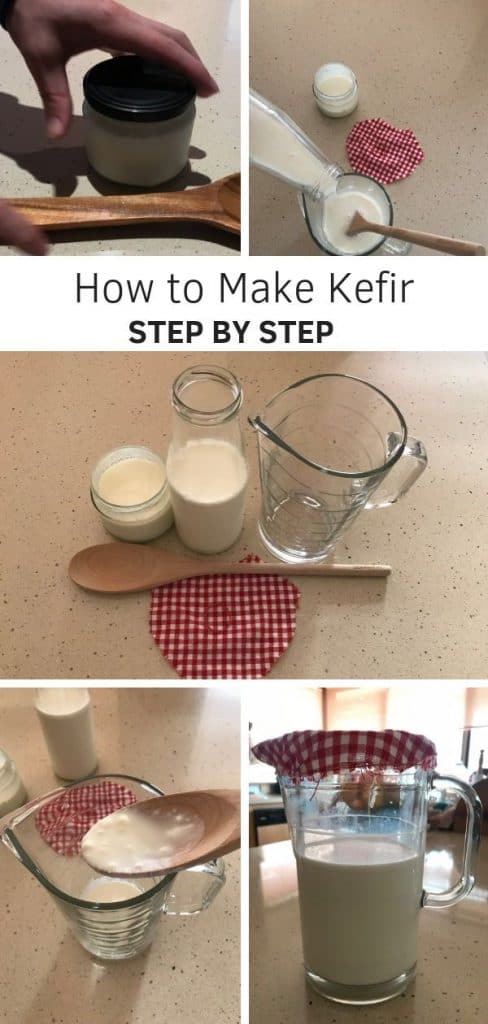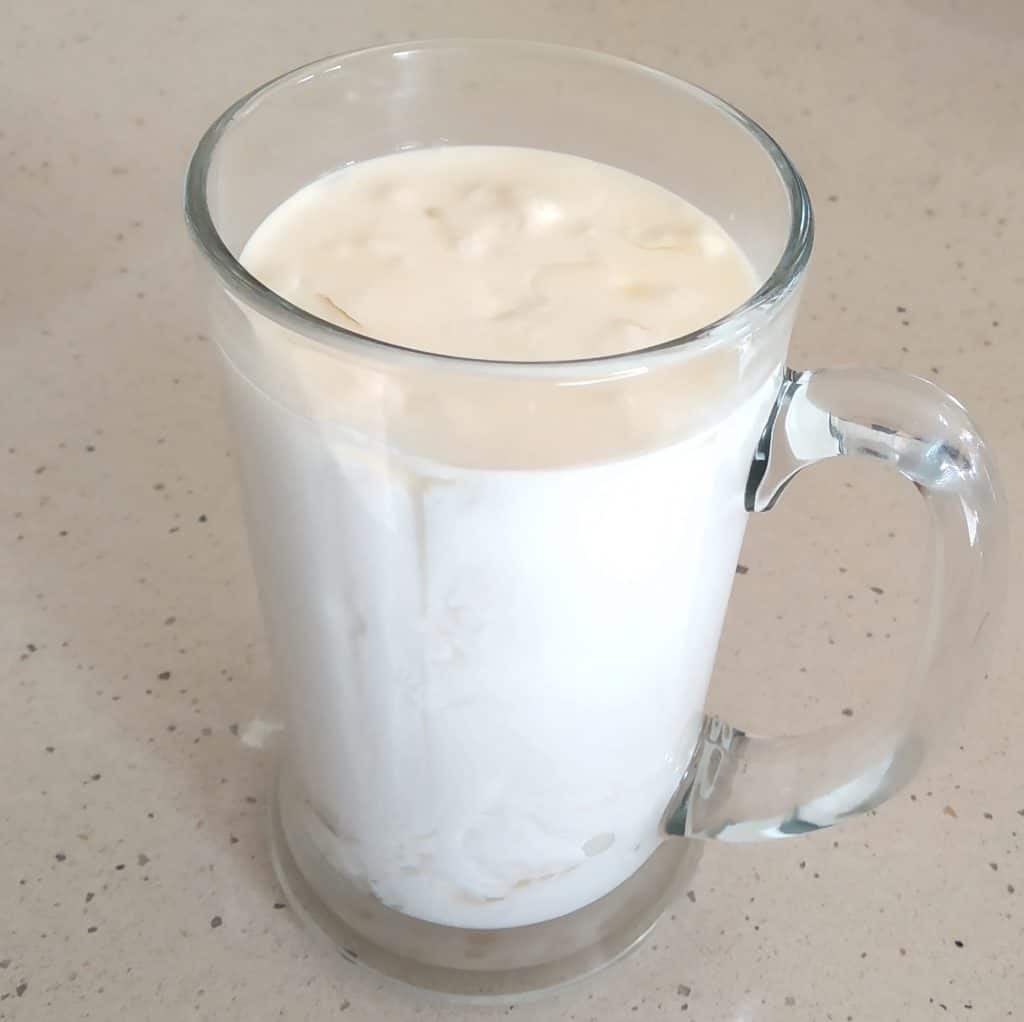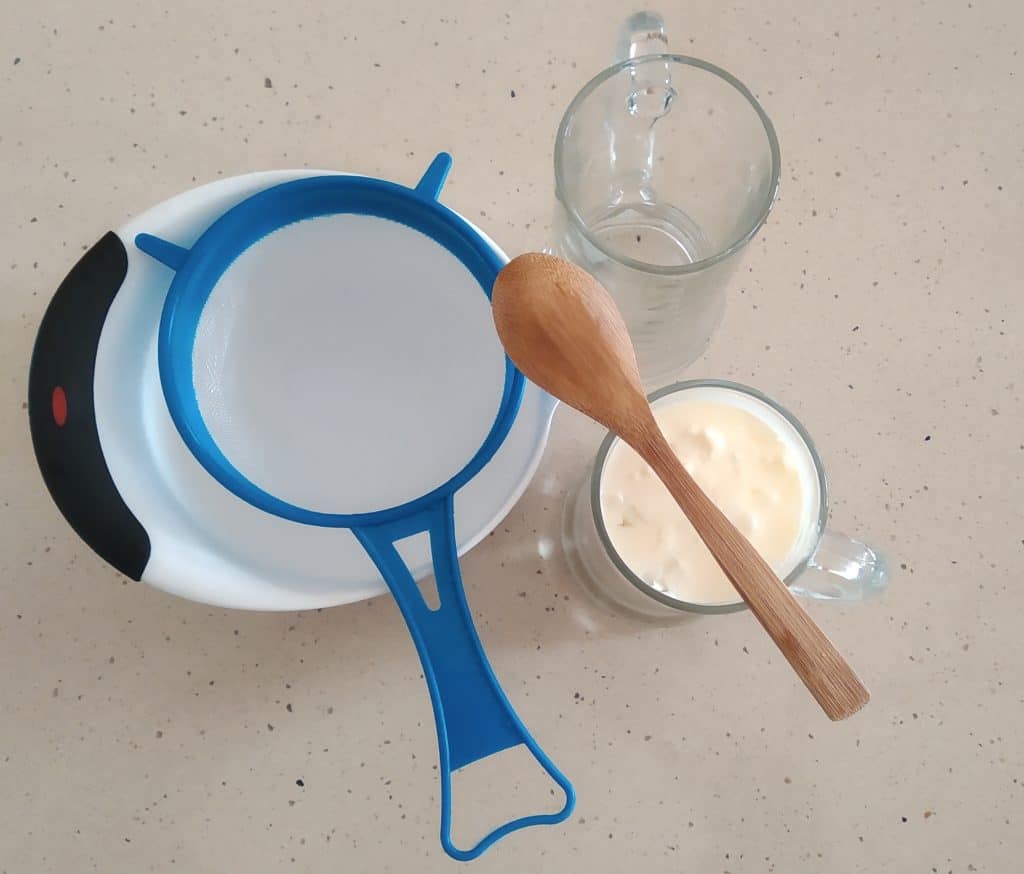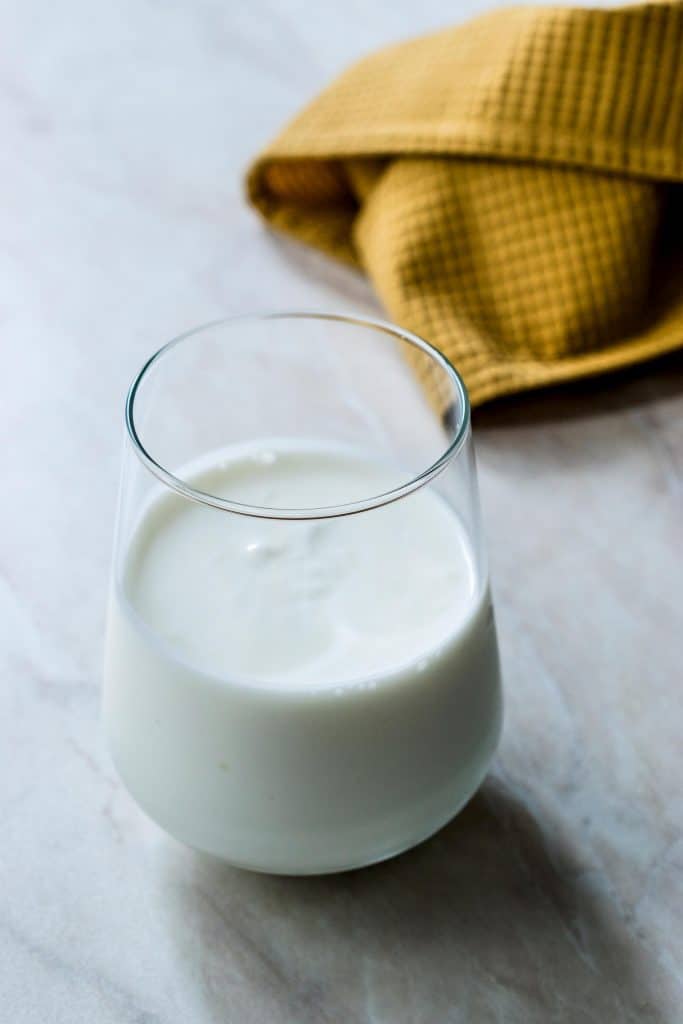![How to Make Kefir [the Only Guide You Need]](https://myfermentedfoods.com/wp-content/uploads/2018/05/Depositphotos_338611552_ds-1-1024x682.jpg)
Kefir is a fermented drink traditionally prepared using cow’s milk. There are non-dairy versions of kefir made with almond milk, coconut water, or juice.

Kefir is made from “starter” grains similar to sourdough bread that needs a “starter” to begin with its preparation.
The lactic acid bacteria in the kefir grains turn the lactose from the milk into lactic acid. This is why kefir has a sour taste just like yogurt, but a thinner consistency.
The starter is a combination of milk proteins, yeasts, and bacteria that allows the drink to ferment while enhancing its flavors and probiotic value.
The milk is fermented by adding to it a small quantity of kefir grains. These are not your usual cereal grains, but the grain-like colonies formed by lactic acid bacteria and yeast having a cauliflower-like appearance.
The microorganisms in kefir grains can multiply and cause fermentation of the sugars in the milk within about 24 hours turning it into kefir. The grains can be removed from the liquid and used again.
In short, kefir is a drink, and kefir grains are the starter or culture needed to produce it.
Kefir is widely accessible in most places. You can buy it from a grocery store or prepare it at home by following a recipe that suits your preferences and health needs the best.
You can learn more about kefir here.
Table of Contents
Non-Dairy Kefir
Though Kefir is usually made with dairy milk, it can also be prepared using non-dairy alternatives such as:
- Goat’s milk
- Coconut milk
- Coconut water
- Rice milk
Since kefir is a fermented beverage, people who suffer from lactose intolerance can drink kefir made of non-dairy alternatives regularly as a replacement for dairy products like milk and yogurt.
This drink is believed to have originated from Southwest Asia and Eastern Europe. The name, kefir, is derived from the Turkish word ‘keyif’, meaning “feeling good”. And this is exactly what kefir does! It makes you feel good with its unique taste and flavors and also by improving your wellbeing. .
Read further to see how drinking kefir regularly can help enhance your wellbeing and help prevent diseases. We will also have a look at the recipes to prepare kefir and the equipment you need so that you can make good use of your time to prepare it at home and enjoy its benefits.
Kefir vs Yogurt
Kefir is often considered an extra fermented version of yogurt. Well…. It may be true to some extent considering fermentation is the integral step of preparing kefir. Also, both these products are traditionally made from dairy products and have a similar creamy-yet-tart taste.
Kefir and yogurt also have plenty of proteins, probiotics, and other nutrients like B vitamins, calcium, and potassium.
However, there are also several differences between kefir and yogurt that are worth knowing.
For example, Kefir usually contains more proteins and probiotics compared to yogurt. Kefir has a thinner consistency while yogurt is comparatively thicker.
And when it comes to the potential health benefits, it is kefir that scores over yogurt. Being richer in probiotics and proteins, it can offer superior results for maintaining your health. In fact, drinking kefir is considered one of the best ways to maintain healthy digestive functions.

Make or Buy
Once you have decided to start drinking kefir, you have two options: You can either buy it from a store or prepare it at home.
Both these options have their own pros and cons based on which you can decide whether you would like to drink store-bought kefir or homemade kefir.
Let me provide you some insights that will help you make the decision:
- Like most other store-bought products, the kefir you buy is likely to contain ingredients that cannot exactly be called healthy. Most packaged products end up compromising the quality of the food in an attempt to create something with a longer shelf life. The addition of preservatives to increase the shelf life makes store-bought kefir less desirable for the health-conscious people.
- Commercial Kefir is usually made available to you in a bottled packaging, there is a risk of bottle explosion as the process of fermentation is not halted. So, the companies suppress the yeast fermentation or culturing that leaves you with kefir having fewer varieties of yeast and bacteria. This is why fermenting your kefir at home is preferred.
- Store-bought kefir may not be as carbonated as the nice and fizzy homemade kefir you can treat yourself with.
- Preparing kefir at home assures you of what ingredients you have added. This could be a great advantage if you suffer from allergies or intolerance to lactose. Since you are aware of the substances you are allergic to, you can make careful choices of ingredients while preparing kefir at home.
- Making kefir at home gives you a choice to customize it according to your dietary needs, and the flavors you are looking for. Store-Bought kefir may not give you many options to choose from.
- You can, of course, save a lot of money by fermenting kefir at home.
- Time constraint is perhaps the only factor that works in favor of buying kefir at a store. If you do not have time to prepare kefir at home, you can definitely buy it at a store may be preferable than not drinking it at all.
Ingredients
Kefir is produced through the process of fermentation, which typically involves different yeast strains and lactic acid bacteria. The primary ingredients you need to ferment kefir include:
- Milk
- Kefir grains
Among these, milk forms the base that needs to be fermented by the addition of kefir grains.
Kefir grains serve as a starter culture to support the growth of healthy bacteria and yeast to ferment the milk.
The bacteria in fermented Kefir might include the strains of Lactobacillus kefir, Lactobacillus bulgaricus, Lactobacillus acidophilus, and Streptococcus lactis. The yeast strains in Kefir may include Saccharomyces cerevisiae, Candida kefir, and Saccharomyces kefir.
The products of fermentation also include lactic acid, carbon dioxide, carbonic acid, and ethanol, which together create the experience of drinking a carbonated beverage that is healthy and refreshing.
Since kefir is a mixed culture, its contents may vary depending on the type of milk used, method of preparation and the conditions it is exposed to.

How to Choose Milk for Making Kefir
From cow’s milk to goat’s milk and low-fat milk, you have plenty of options when it comes to choosing milk for preparing milk kefir.
The milk used for culturing can affect the flavors and characteristics of the fermented kefir.
The texture and thickness of kefir may also vary depending on which animal’s milk you are using or how the milk has been processed.
While most milk culture well, you need to consider some factors while selecting the best milk for kefir.
- Cow Milk: it is the most popular milk used for culturing kefir. Cow’s milk can produce thick and smooth kefir.
- Goat Milk: Goat milk can contribute to thinner kefir. It contains a lower amount of calories, proteins, and fats compared to cow’s milk.
- Sheep Milk: If you prefer your kefir to be sweeter in taste, you can use sheep milk. It contains more proteins and gives you thicker, creamier kefir.
- Non-Dairy Milk: Non-dairy milk like coconut milk can be cultured to ferment kefir using milk kefir grains provided the revitalization period has been observed. This means while culturing coconut milk, kefir grains must be revitalized in animal milk for about 24 hours every few days.
Seed and nut milk are other choices of non-dairy milk for culturing kefir. However, the yield may be inconsistent. - Low Fat Milk: You can use low-fat milk if you are trying to lose weight and want to control your intake of calories from fats.
Save on the ingredients. Sign up for Amazon Fresh and receive a discount on your first order.
How to Get Kefir Grains or Kefir Starter
Kefir grains are the starter or mother culture containing polysaccharides, kefiran being the most important among them. Within its matrix of polysaccharides, both bacteria and yeast co-exist in symbiosis along with the milk it feeds from and cultures.
You can choose the kefir culture based on your preferences and personal needs. Milk kefir grains usually come in either a dehydrated or fresh state.
The best way to get fresh kefir grains is to request a friend or a relative who is already fermenting kefir at home to share a portion with you.
You can also purchase kefir grain online. If you plan to purchase it online, choose a product that can be shipped to you swiftly so that you can place it in fresh milk before it becomes distressed due to the deprivation of food (milk).
Dehydrated kefir grains, on the other hand, are present in a dormant state. So, they do not need to be taken care of as carefully as the fresh grains. They are also not as fragile as the fresh grains. The process of dehydration may create some amount of stress on the culture. However, with proper activation, they can be stimulated to ferment the milk.
Dehydrated kefir grains offer an advantage to those who do not prepare kefir frequently as this starter has a longer shelf life.
Difference Between Kefir Grains and Powdered Kefir Starter Culture
Most people prefer to buy kefir grains while some opt for powdered kefir starter culture. Here are some differentiating factors you need to check before buying kefir grains or powdered kefir starter culture.
- Powdered kefir starter usually contains 7 to 9 strains of yeast and bacteria while milk or water kefir grains contain a long list of strains of bacteria and yeast. Kefir grains offer a more probiotic-rich culture you need to ferment perfect kefir.
- Kefir grains are reusable almost indefinitely. You just need to place the grains in the right liquid and culture it for 12 to 48 hours before transferring the grains to another liquid for fermenting the next batch of kefir.
- Powdered kefir starter is not meant to be reused. However, you may preserve a small amount of it and add it to fresh liquid to prepare a new batch of kefir. With repeated use or re-culturing, the bacteria begin to weaken thus losing their potency to ferment your kefir.
- Kefir grains work well only when cultured in back-to-back kefir batches as it requires an uninterrupted supply of food to survive. This is one reason why some people prefer to use powdered kefir starter that hardly requires any maintenance.
- For the same reason, powdered kefir starter is better suited for people who do not ferment kefir regularly while kefir grains are preferred by those who ferment kefir regularly.
Supplies and Equipment
If you are planning to ferment kefir at home regularly, you can begin with assembling the basic equipment as follows:
- Ball Regular Mouth 32-Ounces Mason Jar with Lids and Bands, Clear,(Pack Of 2)
- A small piece of cloth
- 1 rubber band to secure your jar
- Canning funnel
- Plastic strainer
- Small spatula, or any other utensil for stirring
Milk Kefir Recipe
- Total Time: 24 hours 10 minutes
- Yield: 2 cups 1x
Description
Kefir is a fermented drink made of cow, sheep or goat milk and kefir grains. Kefir grains are white particles consisting of bacteria and yeast mixture clumped together with milk proteins and lactose (natural milk sugar).
You can drink milk kefir as is or use it as a replacement for milk or yogurt while preparing smoothies, and other beverages. Milk kefir can also be used for baking as an alternative to yogurt, or milk.
Ingredients
- 2 cups of milk (whole organic milk recommended)
- 1 teaspoon active kefir grains
Instructions
- Sterilize the jar with boiling water or wash well with warm soapy water. Place kefir grains into a glass jar then add milk slowly and stir well with a wooden spoon. Leave around ⅓ of the jar empty to allow fermentation.
- Cover the jar with cheesecloth and place a rubber band around it. Let the mixture rest at the countertop on the room temperature for 24 hours. If the room temperature is higher than 68 to 72 °F then place the jar in the fridge for 12-24 hours while kefir ferments.
- After 24 hours taste the kefir. If the taste is to your liking, place mesh strainer over a glass bowl and pour the kefir through. Serve kefir as it is or pour it into a glass bottle with lid and refrigerate for up to 7 days. Use kefir grains to make your next kefir batch.
Notes
- If you are using dried kefir grains, rehydrate them by allowing them to soak in milk. Change the milk once every day until the grains start to culture the milk. It can take about 3 to 7 days for the grains to become active.
- If you do not wish to use the kefir grains immediately for the next batch, store them in the freezer. You can also grind a part of it to make a powder. You can sprinkle this powder on sandwiches or salads as a seasoning to increases their health quotient.
- Prep Time: 10 minutes
- Cook Time: 24 hours
- Category: Fermented drink
- Method: Fermentation
- Cuisine: Caucasus
How to Store Kefir
Once kefir is ready (to your liking), strain it through a mesh strainer by separating grains and kefir. Pour the kefir into glass bottles with lids.
Store it in the fridge for up to 7 days. Keep in mind that the fermentation process never stops, which means that the kefir will get more and more sour each day.
It is just a matter of taste – if you prefer lighter flavors, drink your kefir after 24 hours of fermentation while if you like stronger tangy flavor store it for a little longer in the fridge before drinking.
Tips
Let me share with you some tips that will help you ferment kefir correctly:
- Kefir can thrive only if it is fed at least once in one or two days. If not fed regularly, the grains fail to survive. When you are out of town for a longer duration of 2 to 3 weeks, mix kefir and grains separately in a larger quantity of milk and store both in the refrigerator.
This will slow down the process of fermentation and prevent rapid utilization of sugars. This will leave adequate food for kefir and grains to survive and allow them to survive for longer. - If you stay in a warmer country, make sure the grains are not exposed to higher temperatures. Store them at a cool and dry place.
- If you want to rinse kefir grains before adding them to milk, use filtered water for to do so.
FAQs
What does kefir taste like?
Kefir, being a fermented drink prepared from milk, tastes like yogurt. It has a tart and sour taste.
Sometimes, it may taste like a carbonated beverage especially if it has been fermented excessively. The excessive formation of carbon dioxide during the process of fermentation is responsible for this taste.
However, unlike carbonated beverages, kefir is healthy as it does not contain added sugars, additives, and preservatives while being rich in probiotics.
Does kefir have alcohol?
Like most other fermented beverages, homemade kefir does contain a small amount of alcohol.
Alcohol is released during the process of fermentation. However, the percentage of alcohol in it is negligible. It contains just 0.5-0.75% alcohol, which is almost the same amount found in overripe fruits. There are also some options of commercial kefir that do not contain alcohol.
How many calories are in homemade milk kefir?
Usually, a cup of milk kefir contains about 250 calories. The calories are primarily derived from carbohydrates, fats, and proteins in the milk. It also provides several vitamins and minerals that can enhance your wellbeing by supporting normal bodily functions.
The calorie content of kefir may vary depending on the type of milk used. If you want to reduce weight and are following a low-calorie diet, you can choose low-fat milk.
If you are following a keto diet that recommends eating foods rich in fats, you can choose full-fat milk. The higher calorie content due to the fats in milk could support the process of ketosis in your body and help you derive the benefits of the keto diet.

How much kefir should you drink per day?
You can drink kefir 3 to 4 times a day. However, it is advisable to start drinking kefir gradually. Initially, you can drink half a cup of kefir every day for a few days. If you do not experience any side effects or feel your body has adjusted to the effects of kefir, you can slowly start drinking it more often.
It may take about 2 to 3 months for you to notice the beneficial effects of kefir on your wellbeing. However, you can find an improvement in your digestive functions within a week of starting to drink milk kefir.
Does kefir have side effects?
Kefir is not known to cause any serious side effects. Some people may develop loose motions due to the stimulant effect of kefir on bowel movements. They may also experience gurgling in the abdomen and mild bloating.
These symptoms tend to be pronounced for a few days when a person starts drinking kefir. The side effects resolve spontaneously over a period of time once the body and the digestive system get accustomed to its effects.
Is kefir vegan?
It can be.
Kefir prepared with dairy is not vegan.
You can replace dairy milk with vegan options like almond milk or coconut milk which are vegan.
Are kefir grains edible?
Yes. However, they are rather bland or flavorless. They may leave a lingering flavor of kefir in which they were soaked while fermenting it.
However, like kefir, kefir grains are also loaded with probiotics. So, if you prefer, you can consume kefir grains, especially if your body finds it difficult to get accustomed to the acidic nature of kefir.
Simply blend the grains while preparing a smoothie or add it to any beverage that does not involve boiling as higher temperatures can kill the microflora of grains.
You can also dry kefir grains and use them as a seasoning. Crush them to form a powder and sprinkle it on your pasta or salad.
Are kefir grains supposed to float?
Yes, kefir grains are supposed to float on water as they have a lower density. These grains tend to encapsulate a part of the carbon dioxide released by yeast during fermentation. As a result, they become lighter and float.
However, if the grains are bacteria-rich and lack adequate yeast content, they may not float and sink to the bottom of the milk.
Can kefir grains be frozen?
You can store kefir grains in the freezer so that they stay viable for a longer duration. Before storing them in the freezer, you need to wash the grains using filtered water. Place them in a plastic bag or container. Then, add some fresh milk and place the container in the freezer.
Alternatively, you can let the grains dry after you have washed them. You can place them on a piece of kitchen tissue so that the water is absorbed leaving the grains dry. Once they have dried thoroughly, wrap them in a plastic bag and store in the freezer.
Before using them again to prepare kefir, thaw the grains for 12 to 14 hours before adding them to milk.
Can kefir grains go bad?
Endurance is the most wonderful thing to appreciate about kefir grains. So, the chances of them going bad are very low.
However, if the kefir you prepared seems to have separated into whey and curd, it might indicate the grains you used were not good enough or that the kefir has been over-cultured.
Changes in culturing conditions such as the milk used, a new spot for culturing, and sudden change in season and temperature can also spoil kefir grains. If mold appears on kefir grains, it is a definite sign that they have gone bad. You can ensure kefir grains stay alive for a longer duration by storing them in a freezer.
How long it takes to ferment kefir?
Kefir usually takes about 24 hours to ferment. If you have added one teaspoon of grains to a larger quantity of milk, say 3 to 4 cups, it ferments very slowly. Similarly, if you add two teaspoons of kefir grains to milk, it will ferment faster.
If you want to delay the fermentation, you can add a lower quantity of grains and place the mixture in the refrigerator. The lower temperature slows down the fermentation process. Also, fermentation occurs faster when the climate is warmer and vice versa.
What kefir has the most probiotics?
Kefir brands contain varying amounts of probiotics. The best kefir brands are Maple Hill, Lifeway BioKefir, and Redwood Hill Farm as they offer probiotic-rich kefir.
You can improve the probiotic properties of homemade kefir by allowing it to ferment a little longer. However, make sure it doesn’t ferment to the extent it becomes too sour and difficult to consume.
Is there non-dairy kefir?
Yes. As discussed earlier, kefir can also be prepared without using dairy milk. You can replace dairy milk with coconut or almond milk to ferment kefir. These options are suitable for people who follow a vegan lifestyle and do not wish to consume animal products like milk. People who suffer from lactose intolerance can also choose non-dairy kefir.
You can try almond milk to prepare kefir if you are specifically interested in improving the health of your skin and hair. The higher vitamin E content of almonds cam enrich your skin, moisturize it, and reduce acne, wrinkles, and fine lines. It will also help control hair loss, split ends, and hair breakage by making the hair roots and shafts stronger.
Using coconut milk is recommended for keto dieters as MCTs or medium-chain triglycerides in coconut can help them enter into the state of ketosis in a shorter duration.
Conclusion
Kefir offers a rare combination of taste and health. The sour and tingling taste of kefir leaves your taste buds asking for more.
Above all, it hardly takes any time to prepare kefir. This is why people all over the world have already started fermenting kefir at home. So, when are you going to start?
Related posts
Non-Dairy Kefir Recipes [Water & Coconut Kefir]
Kefir – Second Fermentation and Flavoring

Hi, I see so many ratios for kefir. Most say 1 tbsp to 2 cups of milk instead of your 1 tsp to 2 cups.
Hi Tanya,
I’ve started my first batch with 1 tsp and have been doing it for a while that way. I get my desired taste within 48 hours hence my recommendation and the recipe. Starting with 1tbsp is likely to speed up fermentation especially during hot summer months. I’m curious to find about your experience. Feel free to share it.